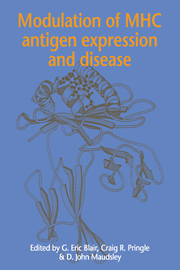Book contents
- Frontmatter
- Contents
- List of contributors
- Preface
- List of abbreviations
- 1 General introduction to the MHC
- 2 Organization of the MHC
- 3 Interactions of cytokines in the regulation of MHC class I and class II antigen expression
- 4 Control of MHC class I gene expression
- 5 Control of MHC class II gene expression
- 6 Modulation of MHC antigen expression by viruses
- 7 Modulation of MHC antigen expression by retroviruses
- 8 Modulation of MHC class I antigen expression in adenovirus infection and transformation
- 9 MHC expression in HPV-associated cervical cancer
- 10 Inhibition of the cellular response to interferon by hepatitis B virus polymerase
- 11 Cellular adhesion molecules and MHC antigens in cells infected with Epstein-Barr virus: implications for immune recognition
- 12 Effect of human cytomegalovirus infection on the expression of MHC class I antigens and adhesion molecules: potential role in immune evasion and immunopathology
- 13 Oncogenes and MHC class I expression
- 14 Mechanisms of tumour cell killing and the role of MHC antigens in experimental model systems
- 15 Manipulation of MHC antigens by gene transfection and cytokine stimulation: a possible approach for pre-selection of suitable patients for cytokine therapy
- 16 Overexpression of MHC proteins in pancreatic islets: a link between cytokines, viruses, the breach of tolerance and insulindependent diabetes mellitus?
- 17 The role of cytokines in contributing to MHC antigen expression in rheumatoid arthritis
- 18 Expression of an MHC antigen in the central nervous system: an animal model for demyelinating diseases
- Index
11 - Cellular adhesion molecules and MHC antigens in cells infected with Epstein-Barr virus: implications for immune recognition
Published online by Cambridge University Press: 11 September 2009
- Frontmatter
- Contents
- List of contributors
- Preface
- List of abbreviations
- 1 General introduction to the MHC
- 2 Organization of the MHC
- 3 Interactions of cytokines in the regulation of MHC class I and class II antigen expression
- 4 Control of MHC class I gene expression
- 5 Control of MHC class II gene expression
- 6 Modulation of MHC antigen expression by viruses
- 7 Modulation of MHC antigen expression by retroviruses
- 8 Modulation of MHC class I antigen expression in adenovirus infection and transformation
- 9 MHC expression in HPV-associated cervical cancer
- 10 Inhibition of the cellular response to interferon by hepatitis B virus polymerase
- 11 Cellular adhesion molecules and MHC antigens in cells infected with Epstein-Barr virus: implications for immune recognition
- 12 Effect of human cytomegalovirus infection on the expression of MHC class I antigens and adhesion molecules: potential role in immune evasion and immunopathology
- 13 Oncogenes and MHC class I expression
- 14 Mechanisms of tumour cell killing and the role of MHC antigens in experimental model systems
- 15 Manipulation of MHC antigens by gene transfection and cytokine stimulation: a possible approach for pre-selection of suitable patients for cytokine therapy
- 16 Overexpression of MHC proteins in pancreatic islets: a link between cytokines, viruses, the breach of tolerance and insulindependent diabetes mellitus?
- 17 The role of cytokines in contributing to MHC antigen expression in rheumatoid arthritis
- 18 Expression of an MHC antigen in the central nervous system: an animal model for demyelinating diseases
- Index
Summary
Introduction: the CTL response to Epstein–Barr virus
Epstein–Barr virus (EBV) is a γ-herpesvirus that is carried by more than 90% of adults worldwide as an asymptomatic persistent infection. This virus is the causative agent of infectious mononucleosis, a benign lymphoproliferative disease and is also implicated in the pathogenesis of an increasing number of malignant diseases, including: Burkitt's lymphoma (BL), nasopharyngeal carcinoma and Hodgkin's disease (Miller, 1990). The importance of cellular immunity, and especially of CTLs, in controlling the potentially harmful consequences of EBV infection is underscored by the increased incidence of EBV-driven lymphoproliferations in organ transplant recipients receiving immunosuppressive therapy and in AIDS patients (Thomas, Allday & Crawford, 1991).
The pathogenic potential of EBV is well illustrated by the ease with which the virus can infect resting B lymphocytes in vitro, causing growth-transformation and the establishment of lymphoblastoid cell lines (LCLs) with infinite doubling capacity. This in vitro infection model provided the first clue as to how the virus is controlled in vivo. If circulating lymphocytes from EBV-seropositive donors are infected with EBV in vitro without first removing or inactivating the T lymphocytes, then the initial proliferation of EBV-infected B lymphocytes is followed by a regression at two to three weeks post-infection because of reactivation of EBV-specific memory T lymphocytes that eliminate the virus-infected cells (Rickinson et al, 1981). Activated T cells isolated from such cultures contain CTL populations that are HLA class I-restricted and specific for EBV-encoded antigens.
- Type
- Chapter
- Information
- Modulation of MHC Antigen Expression and Disease , pp. 261 - 277Publisher: Cambridge University PressPrint publication year: 1995



